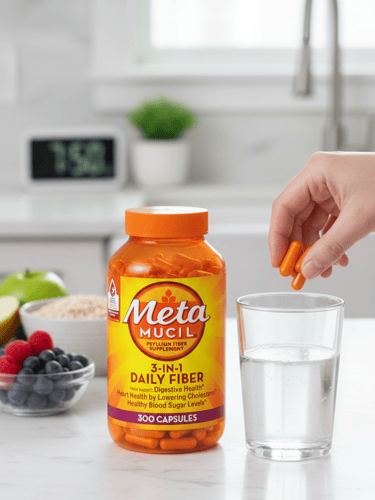How I Lowered my Blood Sugar with Psyllium Husk Fiber
Struggling with insulin resistance? Discover how psyllium husk fiber capsules can help lower blood sugar and stabilize metabolism. Learn from my experience of reducing my A1C from 5.5 to 4.9 in just 6 months. Find out the dosage and critical safety tips for effective results.
10/9/20254 min read


Understanding Insulin Resistance and Blood Sugar Management
Insulin resistance is a metabolic condition characterized by the body's diminished ability to respond to the hormone insulin, which is crucial for regulating blood sugar levels. This dysfunction can lead to elevated glucose in the bloodstream, making it a significant factor in blood sugar management. Various factors contribute to insulin resistance, including obesity, physical inactivity, and poor dietary choices, particularly those low in fiber and high in refined carbohydrates.
When insulin resistance occurs, the pancreas compensates by producing more insulin to help manage blood sugar levels. However, over time, this increased demand can stress the pancreas, potentially leading to its gradual failure and the development of type 2 diabetes. Moreover, insulin resistance is intricately linked with other health issues, such as metabolic syndrome, characterized by a cluster of conditions including increased blood pressure, high triglycerides, and excessive body fat around the waist. These issues pose significant risks to overall health, making blood sugar management a priority.
Maintaining stable blood sugar levels is essential for preventing potential complications associated with insulin resistance. Fluctuations in blood sugar can result in symptoms such as fatigue, irritability, and increased hunger, which further complicates lifestyle management. Additionally, chronic high blood sugar levels can damage blood vessels and nerves, leading to serious health concerns such as cardiovascular disease, kidney problems, and vision loss.
Understanding the connection between insulin resistance and blood sugar spikes facilitates a proactive approach to health management. Through lifestyle modifications such as adopting a balanced diet rich in fiber, engaging in regular physical activity, and monitoring one's carbohydrate intake, individuals can significantly improve their insulin sensitivity and maintain better control over their blood sugar levels. By addressing these factors, one can better articulate a pathway towards long-term health and well-being.
The Role of Fiber in Regulating Blood Sugar
Fiber plays a crucial role in regulating blood sugar levels and enhancing insulin sensitivity, making it an essential component of a healthy diet. Dietary fiber is primarily categorized into two types: soluble and insoluble fiber, each of which has distinct impacts on digestion and glucose metabolism. Soluble fiber dissolves in water, forming a gel-like substance that slows digestion and the absorption of glucose. This gradual process helps prevent rapid spikes in blood sugar levels, which is particularly beneficial for individuals with insulin resistance.
Soluble fiber is found in various foods, such as oats, beans, lentils, fruits, and vegetables. These fibers not only enhance satiety but also contribute to improved gut health by promoting the growth of beneficial gut bacteria. The fermentation process of soluble fiber produces short-chain fatty acids, which have been shown to improve insulin sensitivity, ultimately benefiting metabolic health. In contrast, insoluble fiber does not dissolve in water, providing bulk to the digestive system, thereby facilitating regular bowel movements. While it does not directly influence blood sugar levels as significantly as soluble fiber, it contributes to overall gastrointestinal health.
Incorporating a higher intake of dietary fiber can be advantageous for individuals seeking to manage their blood sugar levels. It mitigates the effects of carbohydrate consumption by slowing down the rate at which sugar enters the bloodstream. As a result, this can lead to a more stable blood glucose profile and decreased insulin demand. Furthermore, a high-fiber diet has been associated with a lower risk of developing Type 2 diabetes and may aid in weight management, another key factor in combating insulin resistance.
Understanding the different types of fiber and their function can empower individuals to make informed dietary choices, promoting better blood sugar control and overall metabolic health. For optimal benefits, one should aim to include a variety of fiber-rich foods in their daily diet.
The Strategic Approach to Fiber Intake
Increasing fiber intake is crucial for enhancing overall health and effectively lowering blood sugar levels, which is key to reversing Insulin Resistance. While we all know to eat foods higher in fiber like whole grains and fruits and vegetables, the recommended daily fiber intake for metabolic health is typically between 30 to 40 grams.
The challenge is that achieving this target can be incredibly difficult by eating whole grains and vegetables alone without consuming an excessive volume of food or calories.
This is why, to truly make a difference in your Insulin Resistance, you should consider supplementing your fiber intake.
Supplementing Fiber for Blood Sugar Control
For a powerful, targeted approach to managing your blood sugar after meals, I recommend using psyllium husk fiber capsules (like Metamucil capsules).
Taking psyllium husk fiber before meals works by forming a thick, gel-like texture in your stomach. This slows down the digestion and absorption of carbohydrates, which, in turn, helps flatten the post-meal glucose spike. This simple strategic supplement can be one of the most effective tools in your diet plan to manage Insulin Resistance and support overall wellness.
My Personal Proof: The A1C Transformation
I can tell you firsthand how powerful this strategy is. I committed to taking a full serving of psyllium husk fiber before eating my four major meals each day.
A Critical Safety Note: Because psyllium husk fiber expands rapidly, it is absolutely essential to take your serving with a full 8-ounce glass of water (or more!) immediately. This prevents the fiber from lodging and expanding in your throat, which can cause choking. Always take with plenty of fluid.
The impact on my metabolic health was profound. In just six months, I was able to lower my A1C (a 3-month average of blood sugar) from 5.5 to 4.9. That shift moved me from pre-diabetic territory into the optimal range, simply by strategically using fiber to manage my carbohydrate digestion.
This shows the incredible potential of consistent fiber supplementation. However, while this was my personal result, please remember that individual results may vary. Always consult with your doctor before making significant changes to your supplement regimen, especially if you have a medical condition. Focus on this simple, consistent step and watch your health markers begin to change!
Connect
Contact
info@marvelouslymidlife.com
© 2025. All rights reserved.
DISCLAIMER: As an Amazon associate and affiliate for other brands, I earn commissions from qualifying purchases.


